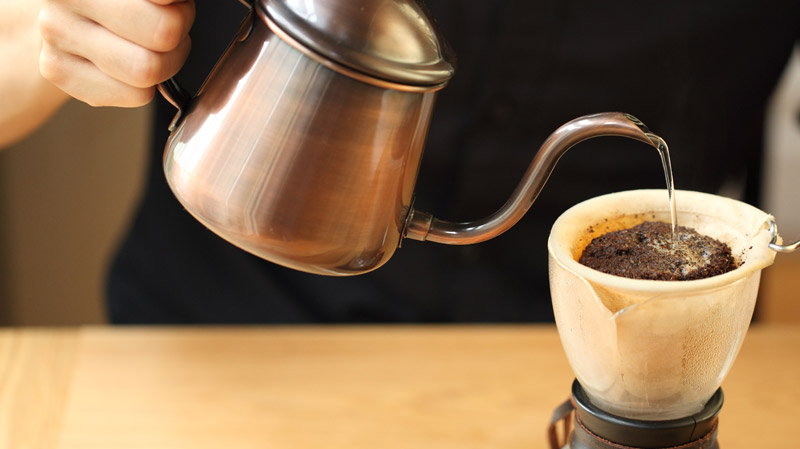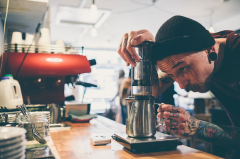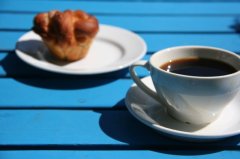Is Sumatra Lindong manning necessarily worse than gold manning?

For professional baristas, please follow the coffee workshop (Wechat official account cafe_style)
Country: Indonesia
Grade: G1 3 times by hand
Producing area: Lindong, Sumatra
Treatment method: traditional wet planing method
Altitude: 1100 to 1600 m
Flavor: baked toast, nuts, pine, caramel, herbs
The most famous producers of coffee in Asia are the islands of Malaysia: Sumatra, Java and Gary Mann. Sumatra Manning coffee from the Indonesian island of Sumatra is the most famous.
Mantenin coffee is produced in Lake dopa in Sumatra Province and Lake Tawa in Aceh. This is the famous "Shuangman of the two lakes". What the Shuangman of the two lakes have in common is that they are both thick and mellow. the difference is that the mantenin of Lake dopa is more stuffy, low and even has the smell of immortal grass, while Mantenin of Lake Tawa is more acidic, sometimes with a smell of cedar or wood.
Gayo Mountain Coffee has a unique taste and high quality. Coffee beans have a strong, unique herbal flavor, a slight honey flavor, moderate and well-balanced acidity. Gayo Mountain Coffee is in line with Blue Mountain Coffee as the world's two most famous coffee!
The coffee named Gayo comes from the local Gayo tribe. They all live in the mountains of central Aceh province, near freshwater Lake Tawar, and people are known as "Gayo" mountains. In the Dutch colonial era, coffee plantations dominated by large estates, but now the vast majority of the local Islamic tribes. They left primitive life to patriarchal tribes; they still followed traditional farming methods. Coffee production comes from about 90% of these small farmers. Due to the small planting area in the mountain area and the small living conditions of farmers, coffee mainly grows manure and farm manure, and the amount of fertilizer is small. Therefore, Aceh Coffee produces mainly organic coffee.
Name: Sumatra Kayuma noodles Mantenin long beans
Producing area: Gayo Lake Tawar, Tawa Lake, Gaiao Mountain
Treatment: wet stripping of Wet-Hulled
Bean seed: Arabica & Ironka variety
Origin: Lake Tawa, Sumatra, Indonesia
Altitude: 1500m-1650
Grade: 2 sieve hand selected long bean Long Berry / > 21 Mesh
Flavor description: smooth taste, clean, high alcohol thickness, Qiaolike flavor, balanced sweetness
Country: Indonesia
Grade: G1 3 times by hand
Company: PWN
Producing area: Sumatra
Treatment method: washing method
Altitude: 1100 to 1600 m
Flavor: baked toast, nuts, pine, caramel, herbs
The most famous producers of coffee in Asia are the islands of Malaysia: Sumatra, Java and Gary Mann. Sumatra Manning coffee from the Indonesian island of Sumatra is the most famous.
To sum up the flavor of the wet planer, apart from those slight differences, we generally think that the wet shaved bean has the taste of soil, tobacco and chocolate, and the sour taste is called "low acid", mellow and dull.
Low acid comes from a shorter, weaker fermentation process and a longer drying time, if you forget the wet plane fermentation, turn back and have a look. As for the "earthy taste" of wet shaved beans, there are different opinions. Some people say that this is related to the beans selected in the wet planing-related producing areas (Tim & Kadim: with Rob pedigree), some people say that this is the result of the organic interaction between raw beans and the outside world, and some even say that it is because there are too many defective beans! Of course, there are a lot of...
There are many sources of defective beans in the wet planing method. First of all, there must be some natural defects in the coffee fruit, and another defect contributor is the shelling part, the corrosion of the wet shell beans during transportation, the damage of sunlight and moisture to the naked raw beans, and one point, the uneven drying speed brought by irregular weather also reduces the flavor. Why did Manning choose by hand so many times? Of course there's a reason for that.
Finally, let's summarize the characteristics of various ways of handling raw beans:
Acidity: washing > semi-washing > honey treatment > wet planing > solarization.
Sweetness: sun > honey treatment > wet planing > semi-washing > washing.
Production risk: wet planing / solarization > washing / honey treatment > semi-washing
Equipment cost: washing / semi-washing > honey treatment / wet planing > solarization
Amount of water used: water washing > semi-washing > honey treatment / wet planing method
Important Notice :
前街咖啡 FrontStreet Coffee has moved to new addredd:
FrontStreet Coffee Address: 315,Donghua East Road,GuangZhou
Tel:020 38364473
- Prev

Which is the best to drink, horse noodle manning or sun manning?
Professional baristas please pay attention to the coffee workshop (Wechat official account cafe_style) Gayo Mountain Coffee has a unique taste and high quality. Coffee beans have a strong, unique herbal flavor, a slight honey flavor, moderate and well-balanced acidity. Gayo Mountain Coffee is in line with Blue Mountain Coffee as the world's two most famous coffee! The coffee named Gayo comes from the local Gayo tribe.
- Next

Costa Rica has a long history of coffee cultivation, large national consumption, and cultivation of high-quality coffee
Coffee cultivation in Costa Rica was introduced from Cuba in 1779 and exported for the first time in 1820. There are about 32,000 coffee farmers, with an average planting area of less than one hectare (10,000㎡) per farmer. Costa Rica population 4.1 million (2006), area under coffee cultivation
Related
- Detailed explanation of Jadeite planting Land in Panamanian Jadeite Manor introduction to the grading system of Jadeite competitive bidding, Red bid, Green bid and Rose Summer
- Story of Coffee planting in Brenka region of Costa Rica Stonehenge Manor anaerobic heavy honey treatment of flavor mouth
- What's on the barrel of Blue Mountain Coffee beans?
- Can American coffee also pull flowers? How to use hot American style to pull out a good-looking pattern?
- Can you make a cold extract with coffee beans? What is the right proportion for cold-extracted coffee formula?
- Indonesian PWN Gold Mandrine Coffee Origin Features Flavor How to Chong? Mandolin coffee is American.
- A brief introduction to the flavor characteristics of Brazilian yellow bourbon coffee beans
- What is the effect of different water quality on the flavor of cold-extracted coffee? What kind of water is best for brewing coffee?
- Why do you think of Rose Summer whenever you mention Panamanian coffee?
- Introduction to the characteristics of authentic blue mountain coffee bean producing areas? What is the CIB Coffee Authority in Jamaica?

